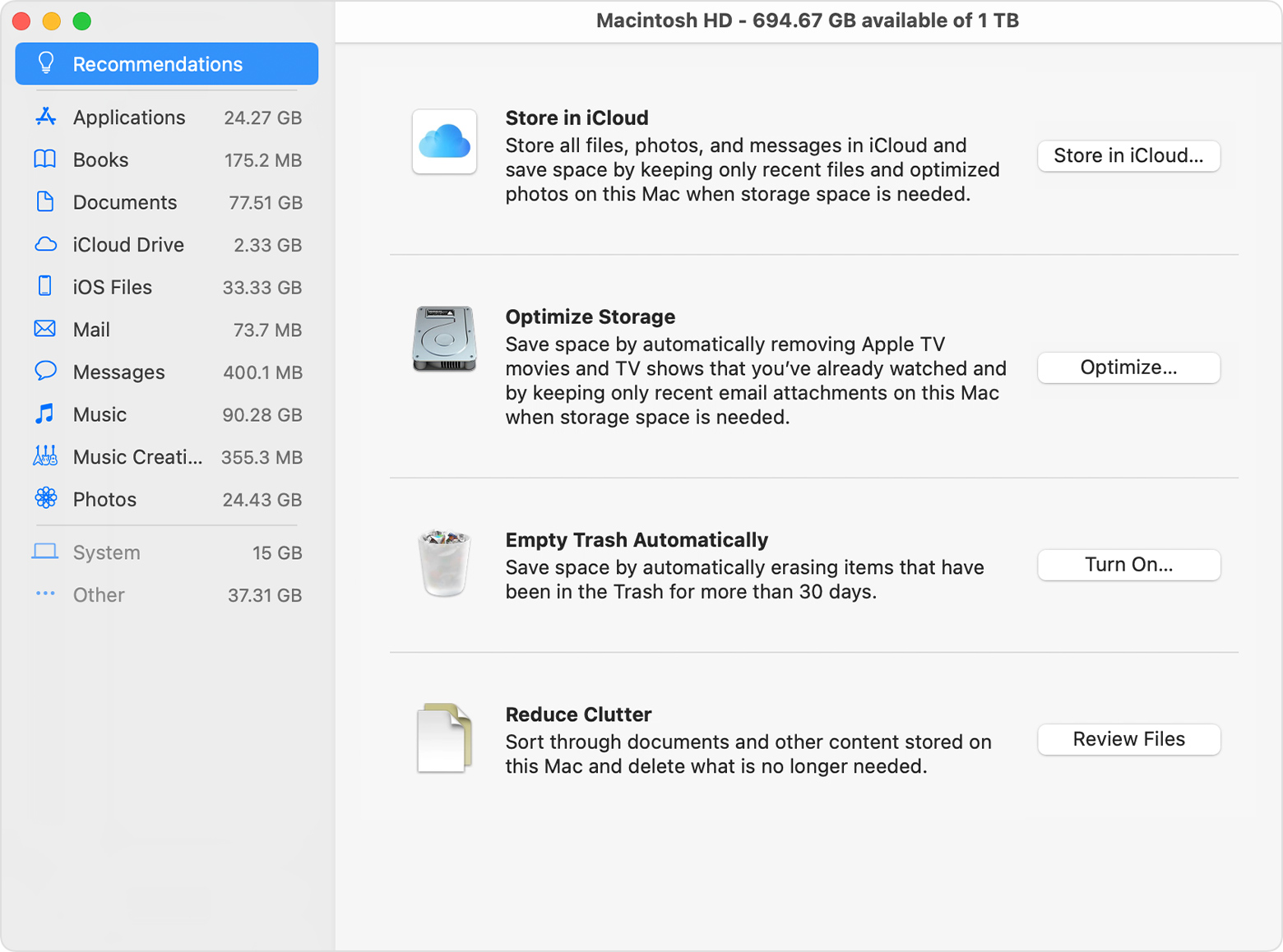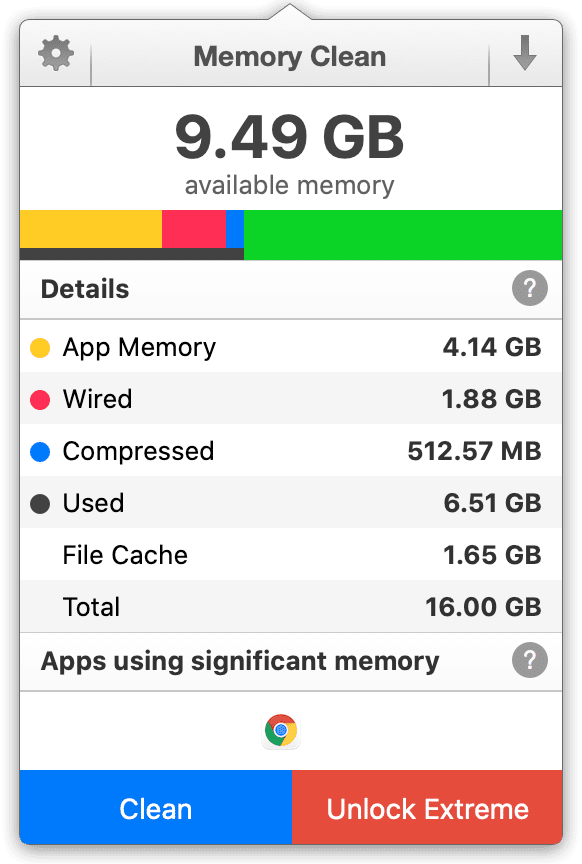How To Free Memory On Mac
Sep 16, 2019 Other 7 Tips to Reduce Memory Usage on Mac Manually. Using a Mac cleaning tool to free up memory on Mac is much easiesr and faster. And this way is highly recommended for time-saving clean up. However, if you want to free up memory without using third-party software, here are other 7 extra tips for you to do the job manually. Jul 15, 2021 The following tips are ways to free up storage space. Restarting the Mac. Restarting Mac solves a lot of problems, so it should help you in freeing up memory on macOS 10.15. It involves turning the Mac off and turning it on again. During the restart process, Mac will clear RAM on macOS 10.15 and present disk crashes. This will help you to free up memory resources, thereby improving Mac’s performance. How to Free Up RAM on Mac To maintain the maximum performance of your MacBook Pro or iMac, it is essential to have enough free hard drive space and a sufficient amount of RAM.
System cleanup in one click
May 14, 2021 How to free up memory on Mac. Knowing how to clear memory on Mac is important, especially if you have a Mac with limited resources. One option is using Activity Monitor: Open Activity Monitor on your Mac; Select an app using a lot of memory; Click the stop icon in the top bar; This is straightforward, but there's a better way. Jun 22, 2021 Free Up Space on MacBook Air or MacBook Pro ( 12 Easy Ways) 1. Delete Large Files on your Mac. Instead of deleting a hundred small files and images, first of all, let us go for the big fish. Click on the Apple logo from the upper left and select About This Mac. Now, click on Storage and then click on Manage. Click Documents.
Sometimes, you need to know how much storage space is on your Mac. Apple doesn’t make this info readily available because not many of us need to know about Mac storage often enough. It’s really easy to check, though – and there are even some alternatives that give you better options for managing your onboard memory!
People need to check their storage space for a variety of reasons. Sometimes it’s just good device management; sometimes your computer is running slowly, and storage is the first culprit you think of. Ideally, about ten percent of the storage space on your Mac should be free at all times so your computer can run smoothly.
Depending on which model you have, this can be tricky to accomplish routinely. Maybe you need to delete some older apps you’re not using, or the app isn’t supported anymore. Maybe you’re just holding onto old documents you no longer need.
Whatever your use-case, here’s how to check disk space on Mac.
Have your storage controlled with Setapp
Get Setapp, an all-in-one toolkit that prevents your Mac from running low on storage. Crucial housekeeping done for you.

How To Check Storage on Mac
It’s actually really simple to check your device’s memory! Here’s how:
- On the menu bar, click the Apple logo in the top left
- Select ‘About this Mac’
- Select ‘Storage’
This is the easiest method for how to see storage on Mac – but you can go deeper! If you need a closer look at your Mac’s memory use, there are a few ways to go about it.
From the Storage screen, you can select ‘Manage,’ which takes you to a new window. Screen record on mac quality. Applications, Documents, Photos, and other sections can be found on the left of this window, and a detailed view of those files on the right.
You can also use Finder! To do so, open Finder, go to the View menu item in the menu bar, and select ‘Show toolbar.’ You’ll see a new bar at the bottom of the Finder window showing the number of items for the section you have selected on the left-hand pane and the total amount of storage your Mac has available.
Check out how to use Time Machine.
Disk Utility is another resource. Open Disk Utility, and it will launch into a view of the volume(s) on your Mac, which also shows how much space is used, and how much is free. (Keep in mind Disk Utility is meant for power users who want to manage their storage, and is a bit of overkill for most users.)
How To Manage Storage in macOS
There are also easy ways to manage the files or applications taking up room on your Mac.
In Finder, select the category from the left side pane, then the application or file you want to delete. Right-click on that file or app, select ‘delete,’ and it’ll be removed. From the System Information menu, simply select the file or app you want to get rid of, and select the ‘delete’ button on the bottom right of the window.
But these two methods often don’t solve the issue! One clever way to better manage the storage on your Mac is to use cloud storage options like iCloud, Dropbox, Google Drive, and OneDrive. Apple’s iCloud is woven into your AppleID, and using it is a very straightforward approach; it’s automatically added to the storage options for your Mac!
But iCloud is not the only solution for cloud storage on Mac. If you have something else, CloudMounter is the easiest and best way to manage all your cloud storage containers. It lives in your menu bar for easy access, and shows all your cloud storage options in Finder. It helps your Mac treat cloud storage as a local disk, making access and managing files really simple!
Best of all, CloudMounter uses 256-bit encryption, so your documents are always safe.
If all the menus and file size jargon of Apple’s Finder and System Information options is confusing, we’ve got a great solution for you. iStat Menus is a handy app that also lives in the Menu Bar, and gives a graphical overview of CPU and GPU use in real-time, network connections, and memory use. Instead of dipping and diving through Apple’s hierarchal menus, you can just click on iStat Menus to get the same information in a much better interface!
iStat Menus also allows you to keep the data surfaced directly on your menu bar. Instead of clicking the icon, you can choose to have things like CPU or memory usage as icons so the information is always available in real-time. Awesome!
Get CMM X to keep your Mac clean
Download the best app that removes clutter — from file leftovers to unneeded apps. So that your Mac never lacks storage.
Probably the best (and definitely the most powerful) option for managing your Mac’s memory is CleanMyMacX. Like iStat Menus, it has a drop-down window from the menu bar showing details like CPU or memory use, as well as which apps may be kicking your Mac into overdrive.
CleanMyMacX really shines when you open it up. The app scans your system and identifies unused files, random system junk, mail attachments – and also manages your trash bins. It scans for malware, checks for privacy leaks, optimizes your system for speedy performance, and does routine maintenance.
That’s a lot, but we’re not done! An option within CleanMyMacX named ‘Space Lens’ is a lot like Apple’s Finder, only better looking and much easier to use. Here you’ll see all your applications and files divided into sections, and broken into sub-menus. You can also manually delete apps or files.
‘Large & Old Files’ is a feature in CleanMyMacX which – you guessed it – finds large files and files you haven’t touched in a long time. The goal is to help you identify which files might be worth deleting, or at least shuffling off to cloud storage. It even tells you how long it's been since you used a file!
But let’s be honest: most of the space on your Mac is probably taken up by apps. And chances are, you don’t want or need most of those apps anyway. This is where CleanMyMacX shines bright! Under the ‘Applications’ menu, you can update and manage apps and extensions with ease.
The ‘Uninstaller’ option is a lot like the ‘Large & Old Files’ option, just for apps. It shows you which apps are old, which may be abandoned (32-bit apps are no longer supported on Mac!), and which are just plain unused. It even shows you how large the apps are, letting you do the quick math on which will free up the most space when deleted.
How To Free Memory On Computer
To get rid of apps or files, simply select them from the CleanMyMacX menu, and select the ‘Uninstall’ or ‘Delete’ option at the bottom of the window. It’s that easy!
Keep your Mac in top shape
Checking and managing the storage on your Mac is simple. While viewing your Mac’s storage is easy to do without having a separate app, there are good reasons to have something beyond Apple’s own options to manage your Mac’s memory.
Apps often have files and folders embedded deep in your Mac’s memory, which don’t always go away when you simply delete the app from Apple’s menus. Installer.dmg seagate wireless. Sure, you got rid of the main offender, but many apps (like those from Adobe) have nuisance files that linger long after you delete the app.

Similarly, moving an app to the trash bin doesn’t actually delete it. The ‘Trash’ app is little more than a place you put apps you don’t want; it doesn’t delete them. You have to manage your trash bin separately, which can balloon out of control.
CleanMyMacX is a great bet for handling it all. It’s smarter at deleting files, folders, and apps, and gives you a much better view of what may be occupying your Mac’s storage. It also removes associated files for apps you delete.

There’s no silver-bullet solution, though! We also like CloudMounter for those with multiple cloud storage solutions, and iStat Menus is really sharp at surfacing the right data when you need it. Best of all, all three options are available for free as part of a 7-day free trial for Setapp, along with dozens of other great apps.
macOS does a pretty good job of managing system memory and, as long as you have a reasonable amount of space free on your boot drive, it can also swap data between RAM and disk when it needs to. However, even the most recent Macs only ship with 8GB of RAM as standard, which can be tight for apps hungry for memory.
In addition, some apps misbehave and “leak” memory, meaning they hog more than their fair share leaving less for other apps. The solution is to use a memory cleaning app to free up RAM. Here, we selected the top 10 best Mac memory cleaners that will help you control memory usage.
If you want to know just how much RAM each app you’re running is consuming, go to Applications > Utilities and launch Activity Monitor. That will display all running processes, including browser tabs, and show you how much RAM they are using.
CleanMyMac X
CleanMyMac X has two methods for cleaning memory. The first is its Maintenance module that has a Free Up RAM tool that can grab gigabytes of memory back with a couple of clicks. The other tool is the CleanMyMac X menu bar item. When it’s running, it will pop up a warning whenever your Mac runs low on RAM and offers to free some up for you.CleanMyMac X also has a System Junk tool that clears out junk files from your boot drive, giving you more space for virtual RAM. The app is notarized by Apple, which means it’s safe to use on a Mac. Download the free version to try out all features.
2. Memory Clean
Memory Clean is a menu bar item that shows how much memory you have available and what is occupying the rest. It also displays the apps that are eating out your Mac’s resources and inactive apps occupying RAM. There are two options for cleaning, Clean and Extreme Clean, and you can also set Memory Clean to free up RAM automatically, so you never have to think about it.

Free Up Memory On Mac
3. Nektony Memory Cleaner
Memory Cleaner is also a menu bar app with a clear, easy-to-read dashboard-style layout. When you click on it, Memory Cleaner displays how much RAM you have in use as a percentage of the total, as well as the apps that are using the most memory. You can then free up RAM with one click.
Memory Cleaner also shows you how much space is being used by junk files on your Mac and allows you to free some of that space up, too.
Macbook Memory Upgrade
4. Memory Diag
Memory Diag is a RAM cleaning tool that not only looks good but does a great job of letting you know when memory is running low. Like others on this list, it’s a menu bar item. In this case, it displays what it calls a memory pressure graph that’s color-coded so you can easily see how much memory your Mac has free. If it’s in the green, no problem. If the meter is deep in the red, though, it’s time to press the recycle button to free up memory. Memory Diag also shows you which apps are taking up most RAM.
5. Memory Magic
Memory Magic is so-called because it works away in the background performing tasks to optimize memory and free up space for applications that need it. If you click on its menu bar item, you’ll see how much RAM you have still available and can, if required, manually force it to recover memory. History graphs allow you to see how often you come close to running out of memory space.
6. Instastats
This menu bar app displays how much memory is occupied and color codes wired, active, inactive, used, and free, so you can see precisely how RAM is allocated at any given time. It does a similar job for CPU, disk space, network, and battery. And it has a Notification Center widget that provides the same information. It automatically cleans memory every five minutes if it is running low.
7. Memory Purge for Mac
Memory Purge is another menu bar tool that helps quickly clean memory. It looks clear and simple and does what you expect: it presents brief memory usage stats and specifies which apps are using a significant amount of memory. You can then click then free up RAM with a single click.
8. Memory Check
Memory Check can display a memory meter in your menu bar showing the percentage of memory currently in use. It will also warn you when memory usage goes beyond a certain level and allow you to free up space. There’s a Notification Center widget and support for Dark Mode.
9. SystemPal
How To Free Memory On Mac Laptop
SystemPal combines a memory monitor and cleaning tool with other features like a mini music player and screenshot utility, as well as CPU and network monitors. The memory monitor displays a pie chart showing how memory is allocated and lists the most memory-hungry processes currently running. There’s also a button to free up memory.
10. iCleanMemory
How To Free Memory On Mac Os
iCleanMemory is the simplest of all the tools here. The menu bar item shows how much memory is in use and how much is free. Click on its icon, and it displays how memory is currently available. If it looks low, press the optimize memory button, and it will free some up.
How To Free Memory On Mac Os
There are lots of options for memory cleaners on the Mac. Some just do one job and sit in the menu bar. Others combine multiple features and allow you to customize them. Which one you choose depends on whether you just want a tool to clean up memory or whether you want other features to help keep your Mac running smoothly.